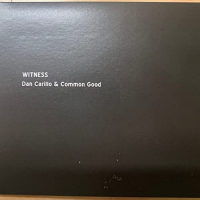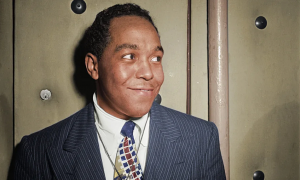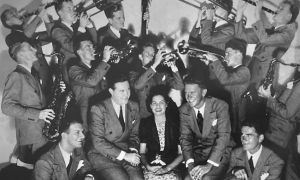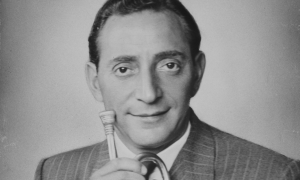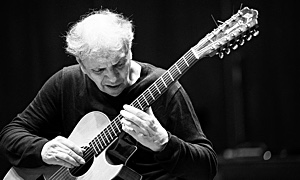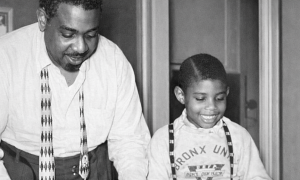Home » Jazz Articles » History of Jazz » Groove Town: Buffalo Jazz And Its Legacy - Historical Insights
Groove Town: Buffalo Jazz And Its Legacy - Historical Insights

Courtesy Barbara Ina Frenz
Today, the Colored Musicians Club ensures that Buffalo's rich African-American music history stays alive. Founded in 1918, the venue was once a major point on the U.S. jazz circuit. Over a century later, it still functions as a live venue and also houses a museum. Another reference point, and an extension of the golden music era in Buffalo, is the Pine Grill Reunion, a music festival that was founded in 1989. The festival keeps alive the cultural legacy of the Pine Grill, a club that Buffalo radio host and jazz enthusiast Guy Cameron recently described as "the epitome of jazz in Buffalo." Coming from the jazz idiom and going beyond it, "groove town" also sparked the musical journeys of four other Buffalonians: Arlester "Dyke" Christian made himself a name with his band Dyke and the Blazers and their hit song "Funky Broadway." Later his music was sampled by Tupac Shakur and Stetsasonic. Rick James became a household name with "Super Freak." He left a strong impact on Buffalo music and the rap and R&B world for generations to come. From the 2010s, rapper Westside Gunn has put the city on the musical map again. And drummer Greg Paul Webster, who lives in LA now, brings in new sounds and musical ideas together with the Katalyst Collective, that he established in 2014.
Situated between New York City to the south-east, Toronto to the north and Cleveland, Detroit and Chicago to the west, Buffalo, New York became a Great Lakes trade and railroad hub. In the 19th century, this region was part of the Underground Railroad. Around 1900, Buffalo was already a major industrial site. Over the years it became the third largest steel producer, the second largest railroad center, and the largest in flour milling. When its economy boomed, steel and iron plants employed 30,000 workers alone. The town's Black population increased enormously with the onset of World War I. Many Southern African-Americans moved to Buffalo to pursue better paying jobs and landed in the town's wartime industries, Bell Aircraft and Bethlehem Steel for instance. They were part of the first Great Migration wave to the North. Even though a minority compared to the huge white population, the Black community in Buffalo was finding their voice and the musicians were an impactful part of it. Building on its activist past, Buffalo became crucial to the formation of the modern civil rights movement with the foundation of the Niagara Movement. Buffalo's Black population continued to grow significantly during the second wave of the Great Migration from the 1940s. Many came to work at the town's manufacturing factories— Republic Steel, Ford Motor Company and others. In parallel to the town's growing economic importance from the early 20th century, the arts thrived in a district named the Jazz Triangle—consisting of various clubs, among them the Colored Musicians Club, the Little Harlem Hotel, the Moonglo, and the Vendome. These clubs made Buffalo an established stop on the Chitlin' Circuit, the nation-wide jazz route with event locations that were safe for Black artists— other stops on that route were New Orleans, Kansas City, Chicago, Detroit, Philadelphia, New York, Albany, Syracuse, Rochester, Pittsburgh, and Cleveland for instance.
The extraordinarily rich tradition of the Colored Musicians Club is closely related to the history of Local 533, American Federation of Musicians (A.F.M.), the labor union of African-American musicians in Buffalo. Local 533 was founded on February 3, 1917, after Local 43, an all- white union which was part of the A.F.M., had refused to include African-American musicians. The racist attitude forced through despite the fact that "in the year 1916 overtures were made to Musicians Local 43 of Buffalo, New York to take in the Negro Musicians." (Raymond Ellis Jackson, president of Local 533 from 1937-43). In contrast to Local 43, Local 533 was open to every musician of appropriate talent. It served as the liaison between musicians and venues. The new union was about fair wages and working conditions for musicians, premier venues for music performance and they supervised designated zones or districts of the city where musical performances took place. Local 533 required each Black musician to sign in when they arrived in Buffalo. Joining the union required a test of musical skill. In 1930, the Local 533 established a screening board—a select group of tough critics, local players with big reputations—that tested potential members in three areas: ability to read music, general musicianship, and ability to perform in an ensemble. Bandleaders often recruited players from Local 533 for gigs in New York, across the US and in Europe. The union was extraordinarily successful compared to other locals in New York State, even during the Depression. At the New York State Musicians Conference from September 24, 1933, Local 533 was one of the few that reported positively of their status: "Membership hold[s] steady (...) Finances of [the] Local [are] good. Doing fairly good business," the report reads.
The year after the foundation of Local 533, in 1918, a group of Buffalo musicians—all members of the new union—formed a social club and named it Colored Musicians Club. In fact, its name originates from a segregated music industry and society, but the Club has always been a place of inclusion. The Colored Musicians Club deconstructed the social disparities that are reflected in its name by its policies. In 1934, the Club purchased its own venue, a two-story building on 145 Broadway, where it is still located today. The first floor was used for meetings of the Local 533, until its merger with Local 43 in 1969. Upstairs was the actual venue with a bar and a stage where international bands and musicians regularly performed and local musicians could rehearse, jam and practice.
On May 14, 1935, the Colored Musicians Club received its charter and became incorporated. Its constitution determined, "to foster the principles of unity and cooperation among the colored musicians of Erie County, N.Y.; to develop and promote the civic, social, recreational and physical well-being of its members; to improve and enhance the professional and economic status of its members; to stimulate its members to greater musical expression; to encourage and develop a fuller appreciation of music on the part of its members and the public; and generally to unite its members in the bonds of friendship, good fellowship and mutual understanding." Looking at the history of the Club, it becomes clear that its members have always been manifesting what their constitution had set out. The Colored Musicians Club "was a place where budding and aspiring musicians could learn their craft and about the details of what it meant to be a professional musician" and "[t]he standards were high from the beginning" (Sabu Adeyola). It was a place of social protection and interaction: The musicians could hang out there, rest and have a reasonably priced meal after their gigs, and on Sundays they could utilize the free space and the piano it provided for their rehearsals. Clarence Becton remembers, that when he "landed up here, I felt I'm home at last. At the time I grew up, it was a community. The older musicians would take the young cats under their wings and not critically put us down. They would show us a better way of doing that. There was a lot of camaraderie. They gave us information and guidance. That's why the Colored Musicians Club was a university." Thanks to the "fraternal open door policy of Local 533" (Sabu Adeyola), musicians in and around Buffalo had the opportunity to meet, associate and perform with artists and performers of the highest level.
The Colored Musicians Club was one of the major venues in town where Duke Ellington, Count Basie, Billie Holiday, Ella Fitzgerald, Dizzy Gillespie, Lena Horne, Art Blakey, Nat King Cole, Max Roach, Sonny Stitt, Gene Ammons, James Moody, Clifford Brown, and Sonny Rollins played and jammed with friends and local musicians. The Club was operated as "a separate entity from the musicians union. All the members of Local 533 were accepted as members of the Club automatically but others could join" (Eggie Riding, vice president of Local 533 in 1969). It was a far-seeing decision of their founders to keep Local 533 and the Club independent from each other. This ensured that the Club remained the Black-owned, flourishing cultural place that it has been from its beginnings—even after the merger of Local 533 and Local 43 to Local 92, which took effect on January 1, 1969 as a final implementation of the Civil Rights Act from July 2, 1964.
"In most cities where there were two locals, the African-Americans were not enthusiastic [about desegregation] because they were generally outnumbered by the other local and would lose power, assets and sometimes property" (Sabu Adeyola). Clarence Becton remembers, that "African-American people got a bad deal on the integration thing. When we had our own union, people who wanted an African-American band, called our union and we often got called for bands. But when the union integrated it wound up that the white people would be in the office and somebody would call for a Black band and they would tell them, 'Oh they are not available, we have a so and so integrated band.'" The Colored Musicians Club withstood these structural disadvantages thanks to its socio-economic autonomy. As a constantly independent, Black- owned business from 1918 to this day, it is unique among the long-standing jazz clubs in the United States. It's not just the only jazz venue still operating, it's the only music or night-life venue of any sort in the former Jazz Triangle area. Buffalo's Broadway now has more abandoned, boarded-up shopfronts than inhabited buildings.
Much the same as in the case of the Colored Musicians Club, the contribution of the Little Harlem Hotel to the local cultural scene is closely connected to Local 533. The Little Harlem, located at 496 Michigan Avenue, was an eminently liberal place to experience jazz during the Great Depression. It was a keystone business in Buffalo's African-American community— as an artistic venue, social meeting place as well as a political hub. Before she established it as a cabaret in 1934, Ann Montgomery—one of the first female African-American business leaders in town and a local icon—ran the business as an ice cream parlor from 1910, a billiard parlor from 1922, and a supper club from 1929. "Cab Calloway, Billy Eckstine, Della Reese, Sarah Vaughan and many others performed and stayed here when downtown hotels were segregated. (...) Famous for its Chinese food and decor, the club was one of the oldest African- American businesses in Buffalo," reads the information board at the club's former site. Also Lena Horne, Billie Holiday, Bing Crosby, and Count Basie played or stayed there. Beyond that, the club was one of the first venues where lesbians and gays were welcome, and it hosted the city's first drag shows. Ann Montgomery booked outstanding female orchestra leaders like Lil Hardin Armstrong and Sherdena Walker. Her club also provided the launching pad for the careers of Stuff Smith, Jimmie Lunceford, and Jean Eldridge, who sang for Duke Ellington and Johnny Hodges.
Originally hired for radio broadcasts, Stuff Smith was hired steadily at the Little Harlem in 1930, where he functioned as the orchestra's leader until 1933. Lil Hardin Armstrong, who was married to trumpeter Louis Armstrong, built up her orchestra at the Little Harlem after her separation from Armstrong. Before that, she led two all-female groups. In 1933, she took over Stuff Smith's orchestra. In a recorded interview tenor saxophonist George Clarke says, that "the whole band quit Stuff and went with Lil," until she left Buffalo and returned to Chicago as a solo artist in 1935. Jimmie Lunceford had played all over the United States before his arrival in Buffalo. He moved to the city in 1931. In an interview from 1934 he explains, "Buffalo was the turning point in my story. While in Buffalo I ran across a few of the men who were in my first band. The idea hit us all at the same time, for within three weeks we had contacted the other fellows and we had formed another band. We tried out in Buffalo and seemed to go pretty big. We avoided as much as possible the old type band which played nothing but 'Tiger Rag' and featured a clarinet that pierced your ear-drums. I was out for something different."
In jazz circles across the US, the Little Harlem was well known. An article on the club in the Chicago Defender from 1935 ("Buffalo Has Red Hot Night Club") let readers know, that " [a]bout the hottest spot in town is Anne Montgomery's 'Little Harlem.' ... Chicago has its Grand Terrace and New York its Cotton Club, but Buffalo steps up for her claim to night life fame with Miss Montgomery's swanky rendezvous for the pleasure-seekers. 'Little Harlem' [has a] marvelous show, fine bar and great band." Ann Montgomery ran the club until 1978, when she died at the age of 87. In 1993, four years after former chief city judge Wilbur P. Trammell purchased it, the Little Harlem was destroyed by fire.
Another musical hot spot in Buffalo was the Pine Grill—located on Jefferson Avenue in the Cold Spring area. Radio host Guy Cameron recently shared his memories and reflections on the legendary place in a video by the Buffalo History Channel. Cameron started going there around 1955/6, still under-age, to see "the who is who of jazz in the 1950s and the 1960s." The Pine Grill was a main stop of the Chitlin' Circuit and primarily known as a place for organ groups, whether trios, quartets or quintets. Around 1956, guitarist Thornell Schwartz came to the club with Jimmy Smith—"the place was mobbed every night" (Guy Cameron). Other notable organists who came through were Bill Doggett with his hip tune "Honky Tonk," Jack McDuff, Richard "Groove" Holmes, Baby Face Willette, Shirley Scott, and Jimmy McGriff. "One of the stellar performances was by the Count Basie Orchestra. They had to take away a few tables and chairs to make the orchestra fit in" (Guy Cameron). The club was known to feature the up and coming musicians— "people wanted to play there, a lot of guys honed their skills in the Pine Grill" (Guy Cameron). Jack McDuff brought in guitarist Grant Green and toured with him for several years, another time he came through with another promising guitarist: George Benson. Every Sunday afternoon there was an open jam session. "I remember Grover Washington Jr. who graduated his high school, he would be there. I remember organist Ronnie Foster, guitarist Lee Ritenour. The Pine Grill was one of those places where you got your start" (Guy Cameron). When the management changed, the program also started changing, which was around 1967. Related to the general stylistic changes in music, their focus was more on r&b from then. But the memories on the legendary jazz venue remained. In 1989, Agnes Baine along with George K. Arthur initiated the annual summer event The Pine Grill Jazz Reunion in Martin Luther King Jr. Park. They were "the inspiration of keeping the music alive" (Guy Cameron)— and it's alive until today with this festival.
There were some more notable clubs in Buffalo's musical heydays. The Revilot, which was located in Cold Spring as well, "became a home for the O'Jays in Buffalo" (Guy Cameron). Another club in that area was The Bon Ton, where the jazz piano trio The Three Sounds with pianist Gene Harris, double bassist Andrew Simpkins, and drummer Bill Dowdy regularly performed. Of world-wide reputation was The Royal Arms Club, which was located in West Utica Street, near Main Street. Vibraphonist Johnny Lytle came through that club on a regular basis, also Thelonious Monk and Miles Davis played there. Clarence Becton started his international career at this place, when he joined Jon Hendricks' band together with bassist John Heard and left his hometown permanently in 1965.
About five years later, in December 1970, Becton was hired for a week-long gig with Thelonious Monk at the Both/And Club in San Francisco. Monk's then musical director, saxophonist Paul Jeffrey, asked him to his utter astonishment, "are you from Buffalo?" Later on, he reflected on the surprising question and came to the conclusion, that "I had some whatever sound, that was influenced by the area in which I grew up, the musical community, that influenced me, and Paul Jeffrey heard that in my playing and he recognized that sound, because he had heard that sound in Frankie Dunlop's playing (Dunlop was Monk's drummer for some years)—Frankie Dunlop grew up in Buffalo. It wasn't specifically because I was playing things Frankie had taught me (Dunlop was an important musical mentor of Becton), but it is a general cultural thing and Paul Jeffrey recognized it."
By the turn of the 20th Century, the musically vibrant times of Buffalo were long gone. The city's economic decline had already left deep marks. Its former industrial economy had turned to low-paying service jobs. The white population fled to the suburbs with the result of a population loss in vast areas of the East Side. Currently, Buffalo is ranked as one of the most segregated cities. Neighborhoods west of Main Street with a mainly white population are affluent. Neighborhoods east of Main Street have seen continued decline. Buffalo rapper Alvin Lamar Worthy aka Westside Gunn features the city prominently in his music and videos, many of the songs reflect its social issues. As an internationally renowned hip hop artist, he gives back to the "groove town" he comes from.
Sources
- Dawoud Sabu Adeyola, Against All Odyssey. The Remarkable Story of Musician Association, Local 533 A.F. of M., Xlibris 2017.
- Rachel Bernstein, Men Working Together: The Colored Musicians Club in Buffalo, undated (online).
- Buffalo Black History Timeline: 1900-1950. Buffalo Bike Tours, February 17, 2021 (online, PDF).
- Buffalo History Channel, The Legacy of the Pine Grill, video, 2021 (YouTube).
- Alison Fraser, with support from the Riverrun Foundation, Little Harlem Club Collection, Rare Books Room, Buffalo/Erie County Public Library. Completed October 2013 (online, PDF).
- Brad Mandell/David Monroe, The Colored Musicians Club. Localwiki, undated (online).
- Nancy J. Parisi, More than 100 years of music at the Colored Musicians Club. Visit Buffalo Niagara, February 5, 2020 (online).
- Giovanni Russonello, James Brandon Lewis, a saxophonist, who embodies and transcends tradition. New York Times, May 5 2021 (online).
- Ern Teck Chua, The History of Jazz in Buffalo is now available online at UB. UB University at Buffalo, April 9, 2013 (online).
- The Public staff, Looking Backward: Ann Montgomery's Little Harlem. The Public, January 7, 2015 (online).
- The Story of Local 533, video documentary (DVD), available at The Colored Musicians Club museum, Buffalo, NY, undated.
- Elen Turner, Buffalo, New York: After The Jazz Age. Mint, Feb 27, 2016 (online).
- Kerry Wolfe, Colored Musicians Club, Buffalo, New York. Atlas Obscura, April 7, 2019 (online).
Tags
History of Jazz
Barbara Ina Frenz
Buffalo
Lil Hardin Armstrong
Jimmie Lunceford
Pete Johnson
Stuff Smith
Dodo Greene
Frankie Dunlop
Clarence Becton
Charles Gayle
Grover Washington Jr.
Juini Booth
Sabu Adeyola
Don Menza
Joe Ford
James Brandon Lewis
Colored Musicians Club
Rick James
New York City
Toronto
Cleveland
Detroit
Chicago
New Orleans
Kansas City
Philadelphia
Albany
Syracuse
Rochester
Pittsburgh
duke ellington
Count Basie
Billie Holliday
Ella Fitzgerald
Dizzy Gillespie
Lena Horne
Art Blakey
Nat "King" Cole
Max Roach
Sonny Stitt
Gene Ammons
James Moody
Clifford Brown
Sonny Rollins
Cab Calloway
Billy Eckstine
Della Reese
Sarah Vaughan
Bing Crosby
Johnny Hodges
Jack McDuff
Richard Groove Holmes
Baby Face Willette
Shirley Scott
Jimmy McGriff
Ronnie Foster
Lee Ritenour
Gene Harris
Bill Dowdy
Johnny Lytle
Thelonious Monk
Miles Davis
Jon Hendricks
John Heard
san francisco
Paul Jeffrey
PREVIOUS / NEXT
Support All About Jazz
 All About Jazz has been a pillar of jazz since 1995, championing it as an art form and, more importantly, supporting the musicians who make it. Our enduring commitment has made "AAJ" one of the most culturally important websites of its kind, read by hundreds of thousands of fans, musicians and industry figures every month.
All About Jazz has been a pillar of jazz since 1995, championing it as an art form and, more importantly, supporting the musicians who make it. Our enduring commitment has made "AAJ" one of the most culturally important websites of its kind, read by hundreds of thousands of fans, musicians and industry figures every month.



